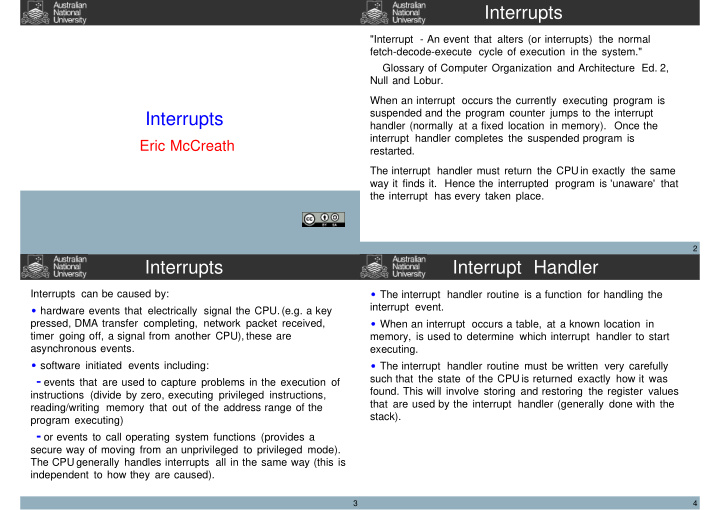



Interrupts "Interrupt - An event that alters (or interrupts) the normal fetch-decode-execute cycle of execution in the system." Glossary of Computer Organization and Architecture Ed. 2, Null and Lobur. When an interrupt occurs the currently executing program is suspended and the program counter jumps to the interrupt Interrupts handler (normally at a fixed location in memory). Once the interrupt handler completes the suspended program is Eric McCreath restarted. The interrupt handler must return the CPUin exactly the same way it finds it. Hence the interrupted program is 'unaware' that the interrupt has every taken place. 2 Interrupts Interrupt Handler Interrupts can be caused by: The interrupt handler routine is a function for handling the interrupt event. hardware events that electrically signal the CPU.(e.g. a key pressed, DMA transfer completing, network packet received, When an interrupt occurs a table, at a known location in timer going off, a signal from another CPU), these are memory, is used to determine which interrupt handler to start asynchronous events. executing. software initiated events including: The interrupt handler routine must be written very carefully such that the state of the CPU is returned exactly how it was events that are used to capture problems in the execution of found. This will involve storing and restoring the register values instructions (divide by zero, executing privileged instructions, that are used by the interrupt handler (generally done with the reading/writing memory that out of the address range of the stack). program executing) or events to call operating system functions (provides a secure way of moving from an unprivileged to privileged mode). The CPU generally handles interrupts all in the same way (this is independent to how they are caused). 3 4
Interrupt Handler Interrupt Handler The interrupt latency is the time between when an interrupt Often the interrupt handler is the very minimum code for happens and the code in the interrupt handling routine starts dealing with the interrupt, anything that can be left for later is executing. left for later. If interrupts are occurring more frequently than the handler Linux, and other operating systems, divide the interrupt can service them, then requests will be lost (interrupt storm). handling routine into 2 halves, the top-half which actually handles the interrupt and the bottom half which later completes the work associated with the event that initiated the interrupt. The top-half would schedule the bottom-half, also because two halves are working on the same data structures they need to be carefully synchronized. 5 6 Masking of Interrupts rPeANUt When an interrupt occurs the current PC is pushed onto the Generally an interrupt handler can be interrupt by another interrupt. stack and the PC is set to the address associated with that interrupt. Some interrupts need to be handled more quickly than others. Any registers used by the interrupt service routine must be Hence there is generally a hierarchy associated with interrupts saved and restored. The interrupt event also sets the interrupt such that interrupts of lower or equal importance do not mask high which should be cleared before the interrupt service interrupt the code of an interrupt handler (the handler first routine finishes. The standard 'return' instruction is used to completes, the mask is removed this enables the pending return from interrupts. interrupt). The interrupts and their addresses are given below: rPeANUt has an interrupt mask bit which is set when an interrupt occurs. If you want the interrupt handler to be interruptable then you need to clean this bit at the begining of the handler. If you don't want this handler to be interruptable then you should clean the mask bit before the handler returns. 7 8
rPeANUt - IO device interrupt rPeANUt - IO device interrupt The IO Device interrupt is disabled by default. If you wish to The handler needs to: enable it set bit 0 of the IO device's control register to 1 (this is store any registers it uses on the stack handle the interrupt, memory mapped so it is a matter of write to address 0xFFF2): handle the interrupt, store ONE 0xFFF2 restore the registers, If the interrupt bit is set then when the a key is hit an interrupt reset the interrupt mask (at some point during the handler), is generated. This and pushes the current PC onto the stack, return from the interrupt. sets the interrupt mask, and The below handler echos key presses: jumps to address 0x0001. iodevhandler : push R0 Because all the address for the interrupts are next to each other load 0xFFF0 R0 store R0 0xFFF0 the handler would normally jump to the code that handles it. pop R0 reset IM 0x0001 : jump iodevhandler return 9 10 Example Exercises Get the timer interrupt to regularly print a "*" to the terminal. Have the main program just spin in a tight loop. 11 12
Recommend
More recommend